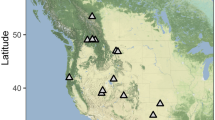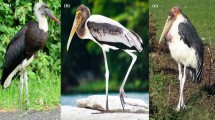Abstract
To predict the consequences of human-induced global climate change, we need to understand how climate is linked to biogeography1. Energetic constraints are commonly invoked to explain animal distributions, and physiological parameters are known to vary along distributional gradients2. But the causal nature of the links between climate and animal biogeography remain largely obscure2,3. Here we develop a bioenergetic model that predicts the feasibility of mammalian hibernation under different climatic conditions. As an example, we use the well-quantified hibernation energetics of the little brown bat (Myotis lucifugus) to parameterize the model4. Our model predicts pronounced effects of ambient temperature on total winter energy requirements, and a relatively narrow combination of hibernaculum temperatures and winter lengths permitting successful hibernation. Microhabitat and northern distribution limits of M. lucifugus are consistent with model predictions, suggesting that the thermal dependence of hibernation energetics constrains the biogeography of this species. Integrating projections of climate change into our model predicts a pronounced northward range expansion of hibernating bats within the next 80 years. Bioenergetics can provide the simple link between climate and biogeography needed to predict the consequences of climate change.
This is a preview of subscription content, access via your institution
Access options
Subscribe to this journal
Receive 51 print issues and online access
$199.00 per year
only $3.90 per issue
Buy this article
- Purchase on Springer Link
- Instant access to full article PDF
Prices may be subject to local taxes which are calculated during checkout



Similar content being viewed by others
References
Gates, D. M. Climate Change and Its Biological Consequences 162–201 (Sinauer, Sunderland, Massachusetts, 1993)
Johnston, I. A. & Bennett, A. F. (eds) Animals and Temperature: Phenotypic and Evolutionary Adaptation (Cambridge Univ. Press, Cambridge, 1996)
Chown, S. L. & Gaston, K. J. Exploring links between physiology and ecology at macro-scales: the role of respiratory metabolism in insects. Biol. Rev. 74, 87–112 (1999)
Fenton, M. B. & Barclay, R. M. R. Myotis lucifugus. Mammal. Spec. 142, 1–8 (1980)
Rosenzweig, M. L. Species Diversity in Space and Time 8–48 (Cambridge Univ. Press, Cambridge, 1995)
Root, T. Environmental factors associated with avian distributional boundaries. J. Biogeogr. 15, 489–505 (1988)
Canterbury, G. Metabolic adaptation and climatic constraints on winter bird distribution. Ecology 83, 946–957 (2002)
Weiner, J. Physiological limits to sustainable energy budgets in birds and mammals—ecological implications. Trends Ecol. Evol. 7, 384–388 (1992)
Kunz, T. H., Wrazen, J. A. & Burnett, C. D. Changes in body mass and fat reserves in pre-hibernating little brown bats (Myotis lucifugus). Ecoscience 5, 8–17 (1998)
Fenton, M. B. Population studies of Myotis lucifugus. (Chiroptera: Vespertilionidae) in Ontario. Life Sci. Contr., R. Ont. Mus. 77, 1–34 (1970)
Webb, P. I., Racey, P. & Speakman, J. R. How hot is a hibernaculum? A review of the temperatures at which bats hibernate. Can. J. Zool. 74, 761–765 (1996)
Johns, T. C. et al. The second Hadley Centre couple ocean–atmosphere GCM: model description, spinup and validation. Clim. Dyn. 13, 103–134 (1997)
Rainey, R. C. in Insect Flight (ed. Rainey, R. C.) 75–112 (Blackwell Scientific, Oxford, 1976)
Schowalter, D. B. Swarming, reproduction, and early hibernation patterns of Myotis lucifugus and M. volans in Alberta, Canada. J. Mammal. 61, 347–350 (1980)
Whitaker, J. O. & Rissler, L. J. Winter activity of bats at a mine entrance in Vermillion County, Indiana. Am. Midl. Nat. 127, 52–59 (1992)
Raesley, R. L. & Gates, J. E. Winter habitat selection by north temperate cave bats. Am. Midl. Nat. 118, 15–31 (1986)
Dwyer, P. D. Temperature regulation and cave-dwelling in bats: an evolutionary perspective. Mammalia 35, 424–455 (1971)
Bell, G. P., Bartholomew, G. A. & Nagy, K. A. The roles of energetics, water economy, foraging behaviour, and geothermal refugia in the distribution of the bat, Macrotus californicus. J. Comp. Physiol. B 156, 441–450 (1986)
Parker, D. I., Lawhead, B. E. & Cook, J. A. Distributional limits of bats in Alaska. Arctic 50, 256–265 (1997)
Twente, J. W. Environmental problems involving the hibernation of bats in Utah. Proc. Utah Acad. Sci. Arts Lett. 37, 67–71 (1960)
Menaker, M. Hibernation–hypothermia: an annual cycle of response to low temperature in the bat Myotis lucifugus. J. Cell. Comp. Physiol. 59, 163–173 (1962)
Pearson, E. W. Bats hibernating in silica mines in southern Illinois. J. Mammal. 43, 27–33 (1962)
Davis, W. H. & Hitchcock, H. B. Notes on sex ratios of hibernating bats. J. Mammal. 45, 475–476 (1964)
Henshaw, R. E. & Folk, G. E. Jr Relation of thermoregulation to seasonally changing microclimate in two species of bats (Myotis lucifugus and M. sodalis). Physiol. Zool. 39, 223–236 (1966)
McManus, J. J. Activity and thermal preference of the little brown bat, Myotis lucifugus, during hibernation. J. Mammal. 55, 844–846 (1974)
Nagorsen, D. W. Records of hibernating big brown bats (Eptesicus fuscus) and little brown bats (Myotis lucifugus) in Northwestern Ontario. Can. Field Nat. 94, 83–85 (1980)
Brack, V. Jr & Twente, J. W. The duration of the period of hibernation of three species of vespertilionid bats. I. Field studies. Can. J. Zool. 63, 2952–2954 (1985)
Thomas, D. W. The physiological ecology of hibernation in vespertilionid bats. Symp. Zool. Soc. Lond. 67, 233–244 (1995)
Nagorsen, D. W. et al. Winter bat records for British Columbia. Northwest. Nat. 74, 61–66 (1993)
Speakman, J. R. & Thomas, D. W. in Bat Biology (eds Kunz, T. H. & Fenton, M. B.) (Univ. Chicago Press, Chicago, in the press)
Acknowledgements
We thank J. Umbanhowar for assistance with model sensitivity analysis as well as D. Kramer and K. McCann for comments on the presentation. This research was supported through a National Sciences and Engineering Research Council of Canada (NSERC) postdoctoral fellowship to M.M.H., and an NSERC research grant to D.W.T.
Author information
Authors and Affiliations
Corresponding author
Ethics declarations
Competing interests
The authors declare that they have no competing financial interests.
Supplementary information
Rights and permissions
About this article
Cite this article
Humphries, M., Thomas, D. & Speakman, J. Climate-mediated energetic constraints on the distribution of hibernating mammals. Nature 418, 313–316 (2002). https://doi.org/10.1038/nature00828
Received:
Accepted:
Issue Date:
DOI: https://doi.org/10.1038/nature00828
This article is cited by
-
Thinner bats to face hibernation as response to climate warming
Scientific Reports (2024)
-
Food availability positively affects the survival and somatic maintenance of hibernating garden dormice (Eliomys quercinus)
Frontiers in Zoology (2023)
-
Fur removal promotes an earlier expression of involution-related genes in mammary gland of lactating mice
Journal of Comparative Physiology B (2023)
-
Modeling heterothermic fitness landscapes in a marsupial hibernator using changes in body composition
Oecologia (2023)
-
Tricolored bats at a southern range edge exhibit partial migration northward in autumn
Movement Ecology (2022)
Comments
By submitting a comment you agree to abide by our Terms and Community Guidelines. If you find something abusive or that does not comply with our terms or guidelines please flag it as inappropriate.



